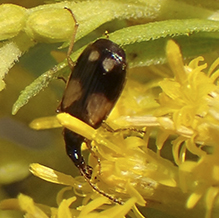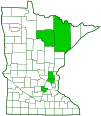ornate harp ground beetle
(Lebia ornata)
Conservation • Description • Habitat • Ecology • Distribution • Taxonomy
Conservation Status |
|
|||||||
| IUCN Red List | not listed |
|||||||
| NatureServe | NNR - Unranked |
|||||||
| Minnesota | not listed |
|||||||
Description |
||
Ornate harp ground beetle is a small colorful foliage ground beetle. It occurs in the United States and southern Canada from the East Coast to the Great Plains. Adults are found in agricultural crops, abandoned fields, and woodland openings. Though called ground beetles, they are found on foliage and flowers in the summer. They feed on plant lice and other insects. The larvae feed on the pupae of leaf beetles. They may be host specific, preying on just one species of leaf beetle. This species has been reported feeding on pupae of the cherry leaf beetle. The larvae pupate in the ground near the remnants of their host prey. Adults are ⅛″ to 3 ⁄16″ (4.0 to 5.5 mm) in length. The body is oval, slender, and black or brownish-black (dark) with dull yellow (pale) markings. It is shiny but it does not have metallic reflections. The head is blackish and smooth, not pitted (punctured). It is constricted in the rear into a neck. The antennae are long and thread-like, and they have 11 segments. They are inserted between the eyes and the jaws (mandibles). The first three segments are pale and yellowish, the remaining segments are darker and brownish-yellow. The mouth parts are directed forward. The exoskeletal plate covering the thorax (pronotum) is broader than long. It is slightly wider than the head and much narrower than the wing covers (elytra). The sides are curved. The lateral margins have a distinct, narrow, flattened, sharp edge. There is an incomplete bead along the rear margin. The upper surface is shiny, smooth, and hairless. The color is variable; entirely dark, entirely pale, or dark with pale margins. The exoskeletal plate between the wing bases (scutellum) is visible. The hardened wing covers (elytra) are broad and flattened. They are long but appear cut off. Unlike most ground beetles, the elytra do not completely cover the abdomen. There is a short ridge at the base and the lateral margins have a distinct, narrow, flattened, sharp edge. Each elytron has several longitudinal grooves. The grooves are shallow and smooth, not punctured. There is a large, pale, tear-drop shaped spot on the basal third originating in the shoulder (humeral) area, and a small pale spot near the tip. The legs are long, slender, and yellowish. The third segment (femur) on each leg is pale. The fourth segment (tibia) of the front leg has a short spur at the tip. The last part of each leg (tarsus), corresponding to the foot, has five segments. There is a pair of claws at the tip of each tarsus. The claws are comb-like (pectinate). |
||
Size |
||
Total length: ⅛″ to 3 ⁄16″ (4 to 5 mm) |
||
Similar Species |
||
Habitat |
||
Agricultural crops, abandoned fields, and woodlands openings |
||
Ecology |
||
Season |
||
Summer |
||
Behavior |
||
Adults are active during the day on foliage and flowers |
||
Life Cycle |
||
Adults overwinter |
||
Larva Food |
||
Larvae of leaf beetles |
||
Adult Food |
||
Plant lice and other insects |
||
Distribution |
||||
|
Sources |
|||
| 6/7/2023 | ||||
Occurrence |
||||
|
||||
Taxonomy |
|||
Order |
Coleoptera (Beetles) | ||
Suborder |
Adephaga (Ground and Water Beetles) | ||
Superfamily |
Caraboidea (Ground Beetles and Allies) | ||
Family |
Carabidae (Ground Beetles) | ||
Subfamily |
Lebiinae | ||
Tribe |
Lebiini | ||
| Subtribe | Lebiina | ||
Genus |
Lebia (colorful foliage ground beetles) | ||
Subgenus |
Lebia | ||
Synonyms |
|||
|
|||
Common Names |
|||
ornate harp ground beetle |
|||
Glossary
Elytra
The hardened or leathery forewings of beetles used to protect the fragile hindwings, which are used for flying. Singular: elytron.
Femur
On insects and arachnids, the third, largest, most robust segment of the leg, coming immediately before the tibia. On humans, the thigh bone.
Pronotum
The exoskeletal plate on the upper side of the first segment of the thorax of an insect.
Scutellum
The exoskeletal plate covering the rearward (posterior) part of the middle segment of the thorax in some insects. In Coleoptera, Hemiptera, and Homoptera, the dorsal, often triangular plate behind the pronotum and between the bases of the front wings. In Diptera, the exoskeletal plate between the abdomen and the thorax.
Tarsus
On insects, the last two to five subdivisions of the leg, attached to the tibia; the foot. On spiders, the last segment of the leg. Plural: tarsi.
Tibia
The fourth segment of an insect leg, after the femur and before the tarsus (foot). The fifth segment of a spider leg or palp. Plural: tibiae.
Visitor Photos |
|||||
Share your photo of this insect. |
|||||
| This button not working for you? Simply email us at info@MinnesotaSeasons.com. Attach one or more photos and, if you like, a caption. |
|||||
Babette Kis |
|||||
Lebia ornata colorful foliage ground beetle Lebia ornata are very small beetles, which I've only found on goldenrod sp. They're hard to spot, due to their size, and their habit of climbing under flowers. |
 |
||||
 |
|||||
MinnesotaSeasons.com Photos |
|||||
|
|||||

Slideshows |
||

Visitor Videos |
|||
Share your video of this insect. |
|||
| This button not working for you? Simply email us at info@MinnesotaSeasons.com. Attach a video, a YouTube link, or a cloud storage link. |
|||
Other Videos |
|||


Created: 6/7/2023
Last Updated:

